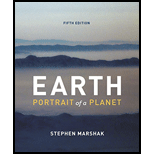
The continental drift hypothesis of Wegener.
Answer to Problem 1RQ
The continental drift hypothesis of Wegener states that the continents were once joined together to form the supercontinent Pangaea and they later drifted apart.
Explanation of Solution
Continental drift hypothesis was proposed by Alfred Wegener and it states that in the past, all the continents were joined together to form a single landmass called Pangaea and later they had drifted apart to form their present configuration.
According to Wegener, the positions of continents change with time. The supercontinent Pangaea existed until the end of Palaeozoic Era. At the time of Mesozoic, they broke and drifted part. As a result, the smaller continents that exist today are formed. He supports his idea based on the data collected from various sources. It includes the matching up of coastlines on opposite sides of oceans, the distribution of Palaeozoic glaciers over the southern end of Pangaea, the distribution of late Palaeozoic equatorial climatic belts that is compatible with the concept of Pangaea, the distribution of fossils, and the distinctive assemblage of rocks that are present on the opposite sides of the ocean adjacent to Pangaea.
Want to see more full solutions like this?
Chapter 3 Solutions
Earth: Portrait of a Planet (Fifth Edition)
- Dike K H Fault L Figure 10.12 Geologic block diagram of a hypothetical area. C Youngest B Intrusion J Oldest "arrow_forwardChrome File Edit View History 0 O ↑ X O SIS Ω 4-511 6 Bookmarks Profiles Tab Window Help X 4-510 X 4-509 + cl.castlelearning.com/Review/CLO/Student/Assignment/Questions?assignmentID=13205009&tid=9976762 0 Qad c 4-511 Select Language 98 Mon May 5 5:26 PM Relaunch to update CED Sal Salvatore Burgio 5009 Which cross section best represents the pattern of sediments deposited on the bottom of a lake as the velocity of the stream entering the lake steadily decreased? -Top 2. esc Bottom Top Bottom Top Bottom Top Bottom Submit Answer Zoom: Standard Note Bookmark Eliminator Highlighter Line Reader Reference Calculator Ruter Protractor MAY LO XA tv N Aa MacBook Pro C D Search or type URL ABGAB 1 2 # $ % & 3 4 5 6 7 8 00 Q W E R T Y U tab A S D F G caps lock shift H H ( 9 0 O + 11 Listen P [ ] J K L ? Z X C V B N M H command option L H fn control option command delete return shiftarrow_forwardI need help with part b and c. I don't want an explanation I need the actual graph, because it's hard to understand an explanation without showing what they mean.arrow_forward
- I need help with part b and c. I don't want an explanation I need the actual graph preferably broken down, because it's hard to understand an explanation without showing what they mean.arrow_forwardI need help with part b and c I don't know how to draw it.arrow_forwardI need help on part barrow_forward
- I need help with part carrow_forwardCan someone one sketch this and show me step by step how they did it.arrow_forward4. What is the geologic range of the fossil shown in Figure 10.15? From the Ordovician period through the Permian period. 5. What is the geologic range of the fossil shown in Figure 10.16? From the Cambrian period through the Permian period. 6. Imagine that you have discovered a rock outcrop that contains the fossils identified in Questions 4 and 5. What is the geologic range of this rock?From theperiod through the period.arrow_forward
- 4. What is the geologic range of the fossil shown in Figure 10.15? From the period through the period5. What is the geologic range of the fossil shown in Figure 10.16? From the period through the period.arrow_forwardACTIVITY 10.6 Types of Fossils Pg 174 1. Refer to Figure 10.13. Which photo(s) (A-1) best illustrate(s) the methods of fossilization or fossil evidence listed below? (Photos/letters may be used more than once.)Permineralization: The small internal cavities and pores of an original organism that are filled with precipitated mineral matter. Photo(s):Cast: The space once occupied by a dissolved shell or other structure that is subsequently filled with mineral matter. Photo(s):Carbonization: Preservation that occurs when fine sediment encases delicate plant or animal forms and leaves a residue of carbon, Photo(s):Impression: A replica of an organism, such as a leaf, left in fine-grained sedimentary rock. Photo(s):Amber: Hardened resin of ancient trees that preserved delicate organisms such as insects. Photo(s):Indirect evidence: Traces of prehistoric life but not the organism itself. Photo(s):arrow_forwardACTIVITY 10.7 Fossils as Time Indicators Pgs 175-176Use Figure 10.14, page 175, to complete the following. 1. What is the geologic range of plants that belong to the group Ginkgo?From theperiod through theperiod. 2. What is the geologic range of Lepidodendron, an extinct coal-producing plant?From theperiod through theperiod. 3. Imagine that you have discovered an outcrop of sedimentary rock that contains fossil shark teeth and fossils of Archimedes. In which time periods might this rock have formed?From theperiod through theperiod.arrow_forward
 Applications and Investigations in Earth Science ...Earth ScienceISBN:9780134746241Author:Edward J. Tarbuck, Frederick K. Lutgens, Dennis G. TasaPublisher:PEARSON
Applications and Investigations in Earth Science ...Earth ScienceISBN:9780134746241Author:Edward J. Tarbuck, Frederick K. Lutgens, Dennis G. TasaPublisher:PEARSON Exercises for Weather & Climate (9th Edition)Earth ScienceISBN:9780134041360Author:Greg CarbonePublisher:PEARSON
Exercises for Weather & Climate (9th Edition)Earth ScienceISBN:9780134041360Author:Greg CarbonePublisher:PEARSON Environmental ScienceEarth ScienceISBN:9781260153125Author:William P Cunningham Prof., Mary Ann Cunningham ProfessorPublisher:McGraw-Hill Education
Environmental ScienceEarth ScienceISBN:9781260153125Author:William P Cunningham Prof., Mary Ann Cunningham ProfessorPublisher:McGraw-Hill Education Earth Science (15th Edition)Earth ScienceISBN:9780134543536Author:Edward J. Tarbuck, Frederick K. Lutgens, Dennis G. TasaPublisher:PEARSON
Earth Science (15th Edition)Earth ScienceISBN:9780134543536Author:Edward J. Tarbuck, Frederick K. Lutgens, Dennis G. TasaPublisher:PEARSON Environmental Science (MindTap Course List)Earth ScienceISBN:9781337569613Author:G. Tyler Miller, Scott SpoolmanPublisher:Cengage Learning
Environmental Science (MindTap Course List)Earth ScienceISBN:9781337569613Author:G. Tyler Miller, Scott SpoolmanPublisher:Cengage Learning Physical GeologyEarth ScienceISBN:9781259916823Author:Plummer, Charles C., CARLSON, Diane H., Hammersley, LisaPublisher:Mcgraw-hill Education,
Physical GeologyEarth ScienceISBN:9781259916823Author:Plummer, Charles C., CARLSON, Diane H., Hammersley, LisaPublisher:Mcgraw-hill Education,





